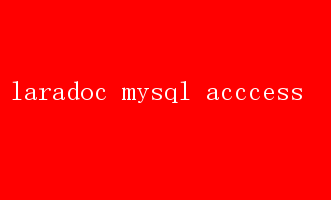Laradoc指南:MySQL访问全解析
资源类型:iis7.top 2025-07-04 20:36
laradoc mysql acccess简介:

Laradoc MySQL Access: Unlocking the Power of Your Database in Laravel In the realm of modern web development, Laravel has established itself as a leading PHP framework known for its elegance, simplicity, and powerful features. One of the cornerstone components of any web application is its database, and MySQL is often the go-to relational database management system(RDBMS) due to its reliability, performance, and widespread use. However, harnessing the full potential of MySQL within Laravel requires a thorough understanding of how to access and manipulate your database using Laradoc, the official Laravel documentation, as your guide. This article delves into the intricacies of accessing MySQL databases in Laravel, leveraging Laradoc to provide a comprehensive understanding. Well cover essential aspects such as configuring your database connection, performing CRUD operations, using Eloquent ORM, and optimizing database queries. By the end, youll be equipped with the knowledge to efficiently manage your MySQL database within a Laravel application. 1. Configuring Your MySQL Database Connection Before you can start interacting with your MySQL database from Laravel, you need to configure the database connection settings. Laravel makes this process straightforward through its configuration files. Step 1: Update the .env File The`.env` file stores environment-specific variables, including your database credentials. Open this file and update the following lines with your MySQL database details: plaintext DB_CONNECTION=mysql DB_HOST=127.0.0.1 DB_PORT=3306 DB_DATABASE=your_database_name DB_USERNAME=your_username DB_PASSWORD=your_password Step 2: Verify the Database Configuration Laravel uses the`config/database.php` file as the default configuration source, but it primarily reads these values from the`.env` file. However, its good practice to verify that the`config/database.php` file has the correct default settings for MySQL: php mysql =>【 driver => mysql, host => env(DB_HOST, 127.0.0.1), port => env(DB_PORT, 3306), database => env(DB_DATABASE, forge), username => env(DB_USERNAME, forge), password => env(DB_PASSWORD,), unix_socket => env(DB_SOCKET,), charset => utf8mb4, collation => utf8mb4_unicode_ci, prefix => , strict => true, engine => null, 】, 2. Performing CRUD Operations Once your database connection is configured, you can start performing CRUD(Create, Read, Update, Delete) operations. Laravel offers two primary methods for interacting with the database: the Query Builder and the Eloquent ORM. Using the Query Builder The Query Builder provides a convenient, fluent interface to building database queries. Here are some basic CRUD operations using the Query Builder: Create: php use IlluminateSupportFacadesDB; DB::table(users)->insert(【 name => John Doe, email => john@example.com, password => bcrypt(password), 】); Read: php $users = DB::table(users)->get(); foreach($users as $user){ echo $user->name; } Update: php DB::table(users)->where(id, 1)->update(【 email => john_new@example.com, 】); Delete: php DB::table(users)->where(id, 1)->delete(); Using Eloquent ORM Eloquent, Laravels Active Record implementation for ORM, provides a beautiful, simple ActiveRecord implementation for working with your database. Each database table has a corresponding Model which is used to interact with that table. Create: php use AppModelsUser; $user = new User(); $user->name = John Doe; $user->email = john@example.com; $user->password = bcrypt(password); $user->save(); Mass Assignment (Create with`create` method): php User::create(【 name => Jane Doe, email => jane@example.com, password => bcrypt(password), 】); Read: php $users = User::all(); foreach($users as $user){ echo $user->name; } Find a Single Record: php $user = User::find(1); echo $user->name; Update: php $user = User::find(1); $user->email = jane_new@exam